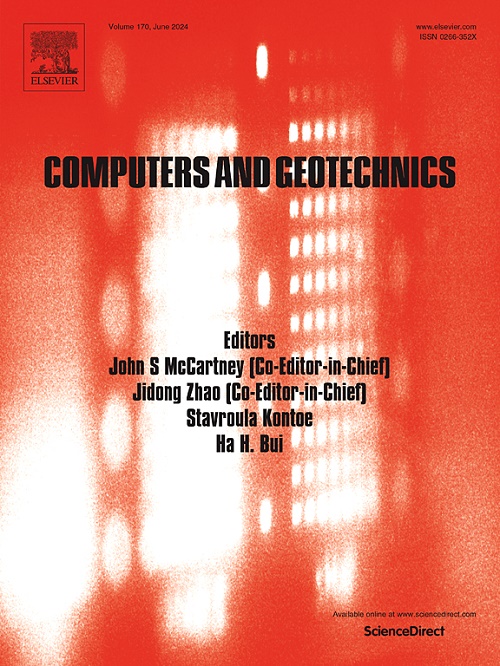砂砾混合物中的多尺度波频散:来自微形态建模的见解
IF 6.2
1区 工程技术
Q1 COMPUTER SCIENCE, INTERDISCIPLINARY APPLICATIONS
引用次数: 0
摘要
本研究提出了一种新的低含砾量砂砾混合料微形态连续体模型,该模型明确考虑了粒径分布、含砾量和结构各向异性的影响。该模型基于宏观微观的能量守恒原理和Hamilton变分原理,系统分析了粗颗粒和细颗粒的运动学以及宏观微观的变形微分。推导了平面波的色散方程,阐明了平面波的传播机理。结果表明,该模型有效地捕获了这些混合物中正常色散特征和尺寸依赖性波传播的影响。在长波长的情况下,波速受宏观特性的支配,而减小波长会引起粒子间散射和多次反射,从而衰减速度或抑制波,特别是当波长接近粒子间间距时。粒径、孔隙率和刚度比主要影响宏观平均刚度,对所有波长域的色散特性具有一致的影响。相比之下,粒度比和砾石含量同时影响宏观力学性能和微观组织组织,在不同波长范围内导致相反的趋势。针对实验的模型验证证实了其对波传播特性的卓越预测能力,包括低通阈值频率、孔隙度、波速和粗颗粒含量之间的关系。该研究为理解砂砾混合料中的波传播及其工程应用提供了理论基础。本文章由计算机程序翻译,如有差异,请以英文原文为准。

Multiscale wave dispersion in Sand–Gravel mixtures: Insights from micromorphic modeling
This study presents a novel micromorphic continuum model for sand–gravel mixtures with low gravel contents, which explicitly accounts for the influences of the particle size distribution, gravel content, and fabric anisotropy. This model is rigorously formulated based on the principle of macro–microscopic energy conservation and Hamilton’s variational principle, incorporating a systematic analysis of the kinematics of coarse and fine particles as well as macro–microscopic deformation differentials. Dispersion equations for plane waves are derived to elucidate wave propagation mechanisms. The results demonstrate that the model effectively captures normal dispersion characteristics and size-dependent effects on wave propagation in these mixtures. In long-wavelength regimes, wave velocities are governed by macroscopic properties, whereas decreasing wavelengths induce interparticle scattering and multiple reflections, attenuating velocities or inhibiting waves, especially when wavelengths approach interparticle spacing. The particle size, porosity, and stiffness ratio primarily influence the macroscopic average stiffness, exhibiting consistent effects on dispersion characteristics across all wavelength domains. In contrast, the particle size ratio and gravel content simultaneously influence both macroscopic mechanical properties and microstructural organization, leading to opposing trends across different wavelength ranges. Model validation against experiments confirms its exceptional predictive ability regarding wave propagation characteristics, including relationships between low-pass threshold frequency, porosity, wave velocity, and coarse particle content. This study provides a theoretical foundation for understanding wave propagation in sand–gravel mixtures and their engineering applications.
求助全文
通过发布文献求助,成功后即可免费获取论文全文。
去求助
来源期刊

Computers and Geotechnics
地学-地球科学综合
CiteScore
9.10
自引率
15.10%
发文量
438
审稿时长
45 days
期刊介绍:
The use of computers is firmly established in geotechnical engineering and continues to grow rapidly in both engineering practice and academe. The development of advanced numerical techniques and constitutive modeling, in conjunction with rapid developments in computer hardware, enables problems to be tackled that were unthinkable even a few years ago. Computers and Geotechnics provides an up-to-date reference for engineers and researchers engaged in computer aided analysis and research in geotechnical engineering. The journal is intended for an expeditious dissemination of advanced computer applications across a broad range of geotechnical topics. Contributions on advances in numerical algorithms, computer implementation of new constitutive models and probabilistic methods are especially encouraged.
 求助内容:
求助内容: 应助结果提醒方式:
应助结果提醒方式:


